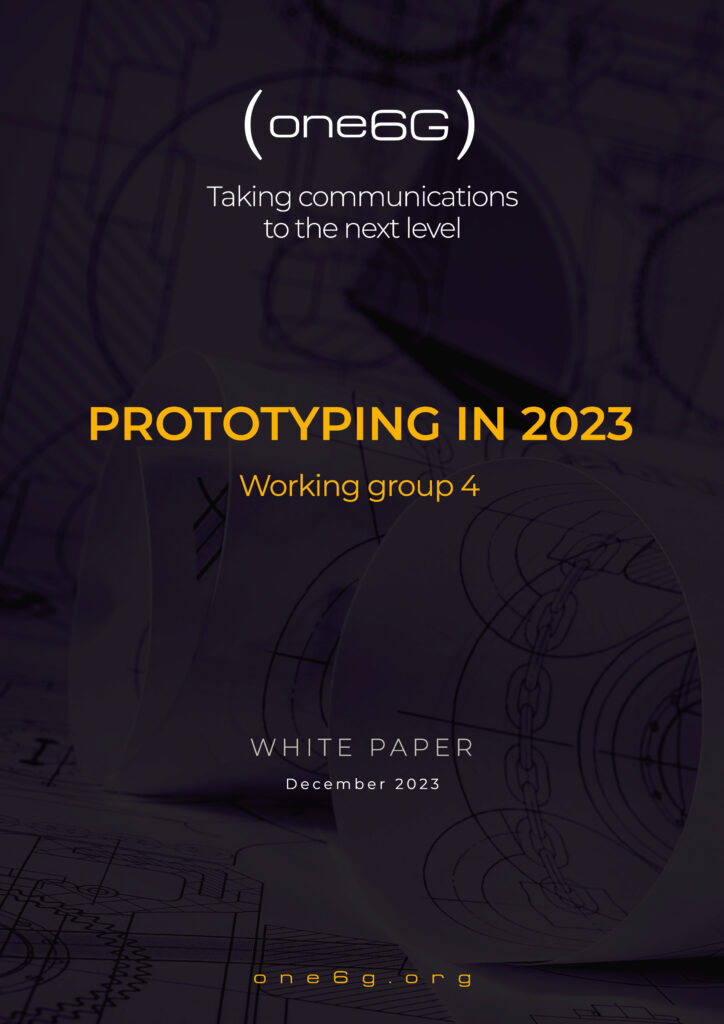one6G publishes a White Paper summarizing the prototyping that took place in 2023
 one6G Association’s Working Group 4 released a comprehensive White Paper titled “Prototyping in 2023.” The paper describes 9 demonstrations presented at the one6G Summit 2023 in Munich, Germany.
one6G Association’s Working Group 4 released a comprehensive White Paper titled “Prototyping in 2023.” The paper describes 9 demonstrations presented at the one6G Summit 2023 in Munich, Germany.
During the one6G Summit 2023, the attendees had an opportunity to examine various technical solutions and discuss them with developers and researchers. During the 2-day event, 9 demo stations were available to the audience. A significant portion of the demonstrations featured robotics as a new promising use case for 6G. A brief summary of the use cases described in the White Paper, as well as videos recorded during the one6G Summit 2023 are available below.
You can download the White Paper in a PDF format for free from here.
Demo 1 Brasil 6G transceiver
The Brasil 6G project aims to develop advanced solutions for 6th-generation mobile communication networks, enabling Brazil to emerge as a hub for information and communication technologies. The project seeks to address national demands in upcoming communication standards, while also developing solutions adapted to the national context based on existing standards. This initiative provides the national industry with an opportunity to position itself in the development and implementation of 6G networks.
Demo 2 Protection against the coronavirus through telemedicine
Exploring the potential of telerobotic medical examinations by expanding on the telediagnostics framework developed in the research project ProteCT. Besides their promising use in telemedicine, emerging robotic applications can play a key role in supporting medical staff in many other areas of the hospital. To maximize synergies, it is essential to develop a fully interconnected medical environment. 6G, as a powerful wireless access technology can hereby help to deeply integrate robotic systems in hospitals and enable the development of truly intelligent novel healthcare applications.
Demo 3 VR robots
Revolutionizing the control of robotic systems by building a human-robot interface which is intuitive and accurate. Extend Robotics demonstrates an intuitive human-robot interface which provides a seamless connection between humans and robots using minimal hardware and with negligible latency. This kind of interface provides easy adoption of robots at affordable cost which is crucial for large-scale deployment of robots in society and for industrial purposes. The Advanced Mechanics Assistance System (AMAS) from Extend Robotics turns a real robot into a physical avatar with a fully immersive remote workspace and 3D vision. The demo showcased a robotic arm (weight ~approximately 7.5 Kg) to be controlled through a VR headset and gesture joystick control.
Demo 4 Intelligent robot empowered by 6G native AI and ISAC
The MELISAC (Machine Learning Integrated Sensing and Communication) robot is a research testbed of the intelligent dual-arm robot empowered by 6G technologies. It is powered by a large language model (LLM), which gives it the ability to understand and respond to natural language. It can leverage both Terahertz signal and optical signal for sensing objects with high resolution. The Terahertz signal can be used for data transmission in the sense of ISAC (Integrated Sensing And Communication). This allows to perceive the world around it in a highly detailed and accurate way, and to communicate with other devices and humans in real time.
Demo 5 Ultrafast sub-terahertz point-to-point wireless link for 6G fronthaul communications
Demonstration of 12.5 Gb/s transmission in the sub-THz frequency band by using a 6.25 GBaud QPSK signal. The flexible testbed allows for real-time processing to generate and demodulate wide band IQ-signals, but also to research and develop sub-components of the system such as up- and down-converter. In this demo, the signal quality was evaluated in terms of bit error rate and constellation diagrams of the actual link. The demonstration was the result of a cooperation between Keysight and Karlsruhe Institute of Technologies.
Demo 6 Beyond 5G localization in 3GPP-compliant scenarios
Real-time simulations of beyond 5G localization fully compliant with 3GPP specifications and environments, in both microWaves (FR1) and mmWaves (FR2), with the possibility to fuse different types of measurements. A menu-driven GUI enables a selection of environments, frequency range, bandwidth, and type of measurements according to 3GPP specifications.
Demo 7 Multitarget tracking and classification via MIMO radar at mmWaves
Demonstration of a real-time system developed for tracking and classifying multiple targets moving in complex wireless environments (e.g., indoor environments) using a single MIMO radar operating at mmWaves. In particular, the system proposes machine learning-based clutter mitigation and target detection to reduce the severe clutter and the multipath propagation that affects reflected waveforms in harsh propagation conditions. Given a set of detections, the proposed approach performs: (i) multi-target tracking (MTT) relying on a soft-decision data association and (ii) classification employing a deep neural network.
Demo 8 6G Integrated communication and sensing in sub-THz band with 270GHz
6G Integrated communication and sensing in sub-THz band with 270GHz based on Huawei baseband / IF boards and R&S frequency up/down converters for H-Band (220 to 330 GHz). Rohde & Schwarz and Huawei have demonstrated subTHz ISAC with multi-static ranging based on Huawei ISAC prototype and the new R&S high-quality up-/down-converter devices.
Demo 9 Communication challenges in teleoperated robotics
In teleoperated robotics, i.e., robots controlled from a distance away, numerous difficulties arise with regard to the communication of data. Especially when multiple modalities (e.g., vision, arm control, audio, hand control) are used, there are several data streams each with their own deadlines that need to be met. This leads us to present the following communication challenge: QoS optimization of multiple channels which need lots of bandwidth, at high update frequency, low latency, and synchronicity between the channels.
